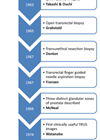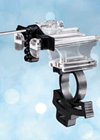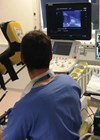In the UK, nearly 100,000 men undergo a prostate biopsy annually, a figure projected to double in the next decade [1]. In recent years, we have observed a paradigm shift in urological practice in numerous UK hospitals. The conventional transrectal, ultrasound-guided prostate biopsy has been entirely superseded by local anaesthetic transperineal prostate biopsy.
This transition is also strongly advocated in the 2023 European Association of Urology (EAU) guideline [2] and is evident in the National Institute for Health & Care Excellence (NICE) consultation on prostate biopsies updated in June 2023 [3].
This article has the aim of educating on optimal utilisation, exploring advantages, and discussing best practices for the CamPROBE (JEB Technologies), a cannulated transperineal access system specifically designed for prostate biopsies [3]. The device is CE and UKCA marked and available to be used in the UK.
Design and components
The CamPROBE is a transperineal access system allowing multiple biopsies to be taken through the same entry point into the perineum. It consists of a coaxial cannula with an integrated needle. As the device does not attach to the ultrasound (US) probe, it requires a so called double freehand technique where both the US probe and the biopsy needle are free to move. It was designed with an integrated needle that can be attached to a standard syringe, allowing the device to be inserted and local anaesthetic to be injected at the same time, under US guidance [3].
Working mechanism / placement of the cannula
After marking the skin at the puncture sites, one on each side, approximately 1cm above and lateral to the anal verge, an injection of local anaesthetic (LA) is performed. In our practice, we use 1% lignocaine solution with a 1:200,000 adrenaline mix. The injection can be preceded by the application of a freezing spray to reduce the initial pain sensation, and we recommend using a fine insulin needle for the skin anaesthesia. Following the skin anaesthesia, a small 2-3mm incision is made using a blade to facilitate the placement of the device. To minimise internal trauma to the deep tissues, the CamProbe tip is non-cutting, hence the need for the initial incision.
Insertion of the cannula and guidance to deliver the LA are performed under US guidance using a linear array endocavity transrectal probe specifically designed for transperineal biopsies. We administer the local anaesthetic under US vision as we advance the needle to minimise any spike in pain by delivering small bolus of LA to specific well innervated anatomical strictures (e.g. perineal muscle). This approach is based on evidence from a 1996 study by Kahneman and Redelmeier [4], who assessed patients’ evaluations of colonoscopy or lithotripsy procedures and correlated the remembered experience with real-time findings. They discovered that patients consistently evaluated the discomfort of the experience based on the intensity of pain at the worst (peak) and final (end) moments, regardless of the length or variation in intensity of pain throughout the procedure. With this in mind, we aim to minimise the ‘peak’ pain and improve the experience at the end of the procedure, considering the potential repetitive nature of this procedure for some patients, such as those on active surveillance. Because of the ability to deliver LA to specific areas, we only typically use lignocaine 1%, 10-15mls in total for the procedure.
Pre-procedure preparation
There is a growing body of evidence suggesting that antibiotic therapy might not be necessary before a transperineal prostate biopsy [2], but we still employ it in clinical practice in line with local guidelines. Routine surgical disinfection of the perineal skin is used for transperineal biopsy. It is important to bear in mind the EAU recommendation not to use fluoroquinolones for prostate biopsy, in accordance with the European Commission’s final decision on EMEA/H/A-31/1452 [2].
Utilising double freehand technique
The patient is placed in the low lithotomy position. One option is to ask the patient to hold the scrotum with their dominant hand as a distraction technique, but alternative methods of holding the scrotum can also be used. A biplanar linear array endocavity transrectal ultrasound (TRUS) probe is used to guide the device and to deliver the LA instillation along the insertion tract, particularly in the perineal muscle, which is the most sensitive part. Once the LA is administered the inner delivery needle as well as the US probe are removed leaving the outer cannula in position and a five-minute allowance for the block to take effect. The biopsy is then conducted using a standard 18G needle through the cannula according to the local protocols in place. In our case, the biopsies are performed using a double freehand technique and a standard template for systematic biopsies, according to the Ginsburg Protocol [5].
The technique is termed ‘double freehand’ because both the US probe and the biopsy needle are free to move. This provides the advantage of more degrees of freedom to reach a desired target more quickly and precisely, but it does require mastery of the TRUS technique. For initial users, we recommend identifying the area of the prostate from which they would like to take a sample, then holding the probe stable and focusing attention on the biopsy needle and its visualisation. The needle needs to be in phase with the US probe, but not necessarily parallel to it. This method offers the advantage of reaching targets more easily in cases of challenging anatomy. Urologists are accustomed to using the ‘double freehand’ technique during percutaneous nephrolithotomy (PCNL) procedures, where the target is even further away from the skin, making the technique more challenging. However, we do not believe that the added complexity in handling the device will be a barrier to adoption.
Procedure after cannula positioning
It is important to make sure that the cannula doesn’t get displaced during the extraction of the biopsy needle. This can be achieved by using the integrated adhesive lined flange to stick and also remembering to straighten the device before the biopsy needle is removed if sampling at an angle. The samples are completed as per the local trust protocols, in our case on sponges and sent differently for different areas of the prostate.
Efficiency and patient comfort
Considering the design and the degrees of freedom, one puncture is enough per prostatic side. This can improve the patient’s need for LA and to make the procedure easily tolerated under LA. In our experience patients tolerated the procedure very well, with excellent patient-reported perception and low pain scores (median of 3, scale 0–10), in line with the paper published by Gnanapragasam et al. in 2020 [6].
Precision and risk reduction
We believe that the double freehand technique offers more degrees of freedom, facilitating easier access to challenging targets, particularly the anterior apical area in large prostates. Additionally, using only two puncture sites for all prostate sizes could potentially reduce the risk of complications, such as bleeding and infection. However, further trials are necessary to determine whether this theoretical advantage translates into improved clinical results. It may be necessary for practitioners to be advanced users of the TRUS technique before adopting this device, and the learning curve will likely depend on previous experience.
Cost consideration
A cost-benefit analysis needs to be considered in the wider context of complications, need for re-do biopsies, etc. and we do not have enough data at present to draw any definitive conclusions. However, a detailed health economic paper on the cost utility of LATP devices is available from Wilson et al. [7].
Considerations for clinicians
For the inaugural lists urologists might want to consider having a visiting proctor. We found the instructional videos very informative [8,9] and would advise watching them. In our initial experience after the research induction we completed the list with no visiting doctor and the patient experience as well as the team experience was very positive.
Real-world applications
In our inaugural list, as part of the CamPROBE clinical trial, we conducted biopsies on four patients. In the second list, we performed six CamProbe transperineal biopsies under LA. This demonstrates that adopting this new device should not impact the efficient use of lists to provide prostate biopsy services. All the biopsies were accurate, and in this unselected group of consecutive patients requiring LA transperineal prostate biopsy, the cancer detection rate was 60%. It is important to note that 40% of the biopsies were conducted on patients with no lesions seen on MRI or PIRADS < 3, as the trial was conducted in 2019. At that time, we were evaluating the role of MR prostate in stratifying the risk of prostate cancer in our clinical practice and guiding the selection of patients for prostate biopsy. We view the introduction of CamProbe as a natural evolution from the single freehand technique.
The future
We emphasise the importance of utilising data to drive change in clinical practice. We advocate for the use of tools to audit patient experience and digital tools to record details of prostate biopsies, histology reports, and MR results. Employing data not only allows for continuous assessment of the quality of care delivered but also fosters improvement.
Conclusion
We have perceived the introduction of CamProbe as a natural progression from the single freehand technique. We stress the necessity for implementing change driven by data, and advocate that a digital platform or a database should be initially employed to collect and audit the results.
References
1. Department of Health and Social Care. New hospitals join pioneering study to improve prostate cancer diagnosis using AI. 2021.
https://www.gov.uk/government/news/
new-hospitals-join-pioneering-study-to
-improve-prostate-cancer-diagnosis-using
-ai#:~:text=Prostate%20cancer%20is%20the
%20most,cancer%20in%20England%20every%20year
[accessed 3 October 2023].
2. EAU. Guidelines on Prostate Cancer - Diagnostic Evaluation.
https://uroweb.org/guidelines/prostate-cancer/chapter/
diagnostic-evaluation
[accessed 3 October 2023].
3. NICE. Recommendations | Transperineal biopsy for diagnosing prostate cancer | Guidance. 2023.
https://www.nice.org.uk/guidance/
dg54/chapter/1-Recommendations
[accessed 3 October 2023].
4. Redelmeier DA, Kahneman D. Patients’ memories of painful medical treatments: real-time and retrospective evaluations of two minimally invasive procedures. Pain 1996;66(1):3-8.
5. Hansen N, Patruno G, Wadhwa K, et al. Magnetic resonance and ultrasound image fusion supported transperineal prostate biopsy using the ginsburg protocol: technique, learning points, and biopsy results. Eur Urol 2016;70(2):332-40.
6. Gnanapragasam VJ, Leonard K, Sut M, et al. Multicentre clinical evaluation of the safety and performance of a simple transperineal access system for prostate biopsies for suspected prostate cancer: The CAMbridge PROstate Biopsy DevicE (CamPROBE) study. J Clin Urol 2020;13(5):364-70.
7. Wilson ECF, Wreford A, Tamer P, et al. Economic evaluation of transperineal versus transrectal devices for local anaesthetic prostate biopsies. Pharmacoecon Open 2021;5:737-53.
8. JEB Technologies. CamPROBE Instructional Video. 2023.
https://www.youtube.com/
watch?v=9LFh3DnyT34
[accessed 3 October 2023].
9. Henleys Medical Supplies. CamPROBE - A Step by Step Guide. 2023.
https://www.youtube.com/
watch?v=a6qgOGVWals
[accessed 3 October 2023].
Declaration of competing interests: None declared.







